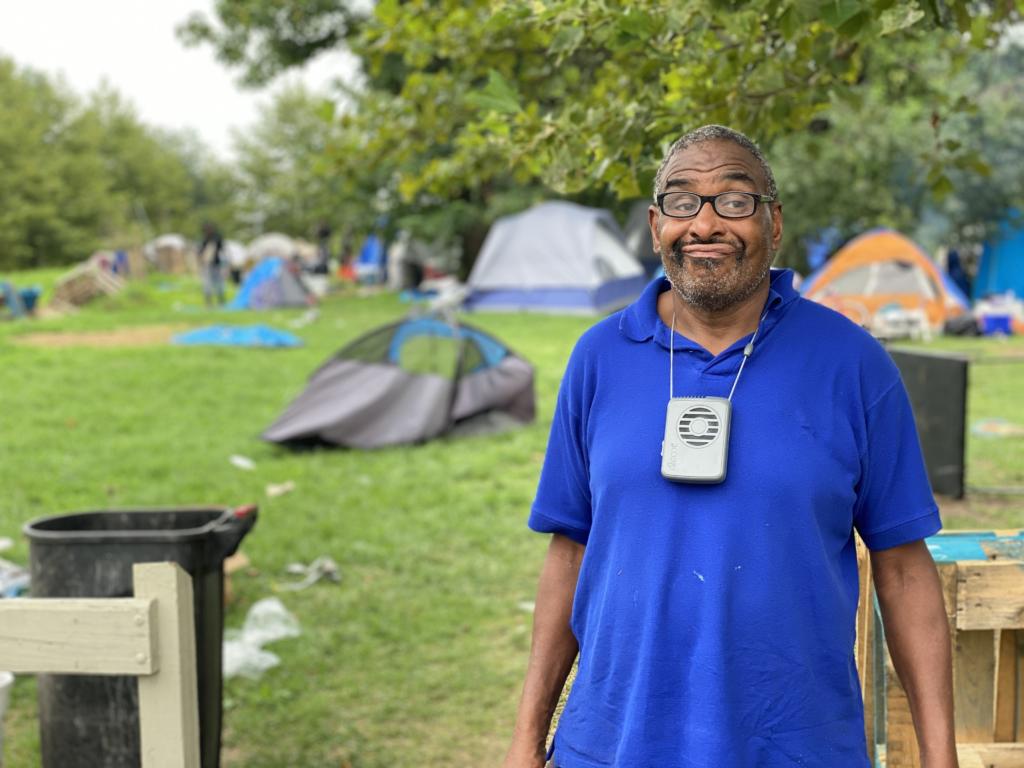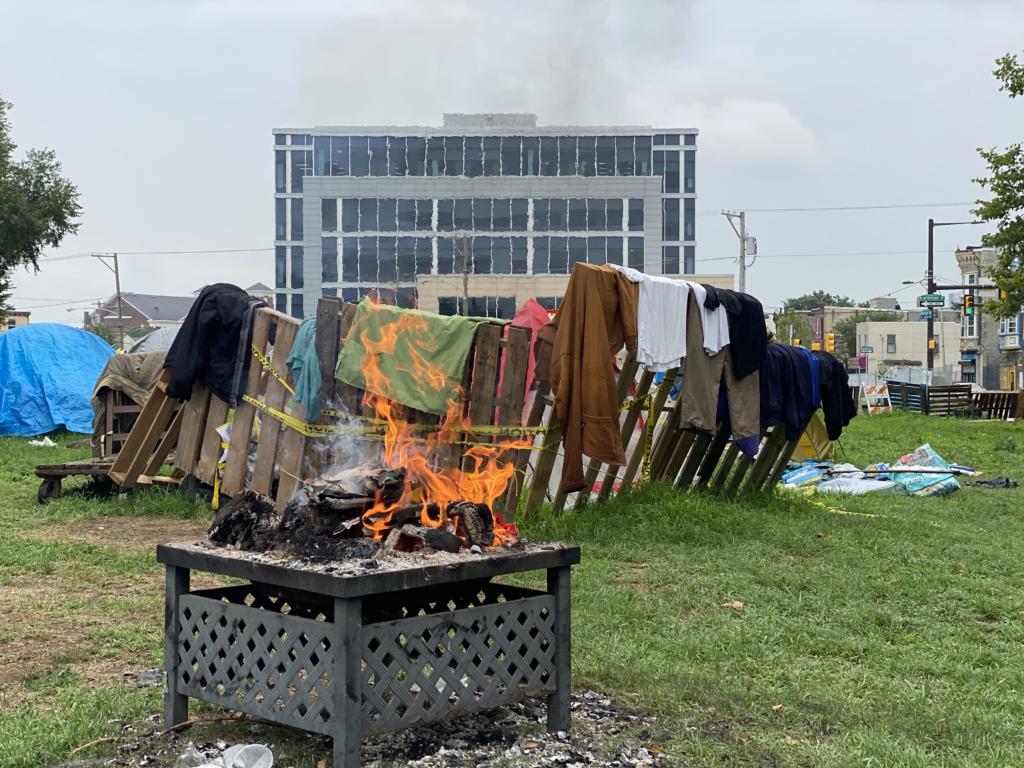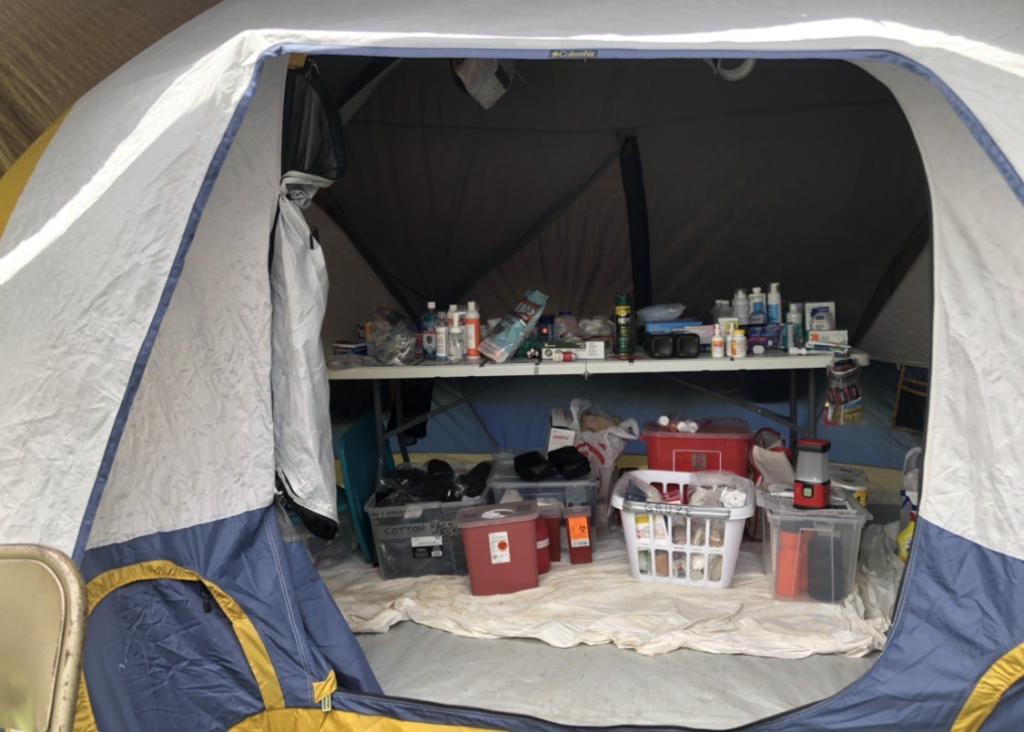From early June to mid-August, Philadelphia’s homeless population created two protest encampments that function as complex communities for the unhoused.
The encampments provide stability for residents, headquarters for donations and protection from outside agitators, as well as the city’s dreaded “service days.”
“I’ve had my stuff thrown out on service days,” said Jonnell Flowers, a resident at the James Talib Dean Camp. “Service days are when the police and the trash people throw all of our stuff away.” Flowers and her husband Leonard’s house burned down and they were two of the first residents at the encampment on 22nd and Benjamin Franklin Parkway.
So far, the camps have survived two city threats to clear out the residents, but the future is anything but certain.
On July 10, Philadelphia Police, along with park rangers, warned residents of the JTD Camp they were to be evicted on July 17. Eviction day came and went, but the camps remained intact. The city also tried on Aug. 17 to evict the encampment on just 24 hours notice, but then balked again. Following the city’s second failed eviction attempt, there is an “emergency hearing” slated for Thursday, Aug. 20 at which encampment residents will testify.
Protesters and supporters of the encampment came out in hundreds to support the unhoused on both eviction dates. Optics of the police fighting protesters and ripping down homeless people’s tents would not have looked good for a city already protesting against excessive police force and a “progressive” mayor who has let down much of his base. The city’s service days strip homeless people of the few belongings that they may have. Service days often leave the homeless with even less than they previously had, relegating them from sleeping in a tent on grass to the city’s pavement.
The specifics of homelessness are where the harshest realities are unearthed.
“It’s so hard to get a job without a house. No mailing address, nowhere to shower. How do I pay bills or get welfare? I can’t even get an Obama phone,” Leonard Flowers said. Access to unemployment, welfare or even the COVID-19 stimulus checks are inaccessible to many homeless people who arguably need assistance most.
Philadelphia’s encampments grew from just five tents in early June to nearly 300 tents across two camps in mid-August. The second encampment, Camp Teddy, was established outside of the PHA’s brand new $45 million headquarters to draw attention to the Philadelphia Housing Authority’s role in the housing crisis. Philadelphia has sold more than 2,300 properties for $1 since 2000, and half remain vacant.
“It is the City of Philadelphia – not PHA – that receives federal funds for providing transitional and homeless housing. PHA’s actions are restrained by budget limitations, which is why the waitlist for housing has been closed for years while the backlog is addressed.”
– Kelvin Jeremiah, CEO of the Philadelphia Housing Authority
“They are operating more like a private developer selling properties and trying to build commercial real estate. They want to do everything but their job, which is to house people,” says Jennifer Bennetch, who was homeless from 2003-2010 and is the founder of #OccupyPHA about the Philadelphia Housing Authority. Bennetch has a “list of 500 viable vacant PHA houses in Philly, the city says they’re not viable,” she continues. “I know the people who lived in those houses, those houses are fine.”
#Occupy PHA, Workers Revolutionary Collective, and the Black and Brown Workers Cooperative have been assisting the unhoused community in Philadelphia. In July, those three groups, Bennetch included, helped to move homeless people into vacant houses.

“When families were reaching out to me saying there was no space in the shelter and they had nowhere to go, I just thought about the Moms for Housing, so we started moving people into these vacant houses back in March,” Bennetch said.
“Before people say ‘no one owes unhoused people anything,’ as long as the CEO of the Housing Authority is making $300,000 and working with multi-million dollar budgets, they do owe us something,” continued Bennetch.
In a WHYY op-ed, CEO of the PHA, Kelvin Jeremiah, dismissed the idea of giving Philadelphia’s homeless population access to vacant properties. Jeremiah went as far as to claim that homelessness is not the PHA’s problem.
“It is the City of Philadelphia – not PHA – that receives federal funds for providing transitional and homeless housing.” Jeremiah continues to explain that, “PHA’s actions are restrained by budget limitations, which is why the waitlist for housing has been closed for years while the backlog is addressed.”
When asked for comment on the PHA’s vacant houses, Councilman Derek Green echoed Jeremiah’s assertion that homeless people cannot “jump the line” to housing over the extremely backed up waiting list. Neither the City Council, nor the PHA seem to have any solutions for the residents of Philadelphia’s homeless encampments.
“Give us an apartment building, we will fix it up ourselves so we can get these people off the streets. The city has buildings they’re selfishly holding onto when they could be out here helping us,” said Jonnell Flowers. “It’s a simple solution to a long overdo problem.”
The residents of the JTD Camp and Camp Teddy are forced to endure the intense heat and torrential rain without proper shelter. Consider these long summer days, then imagine never going indoors. A few hundred homeless people have successfully created an infrastructure that provides safety and community for one another as they fight toward a greater goal.
In addition, the role of the coronavirus cannot be downplayed in reference to the camps. Many shelters had to cut back their intake, and, beyond that, many of Philly’s homeless do not feel safe in the city’s shelters. The strange effect of COVID-19 on the homeless population nationwide is still barely understood, and experts in Boston and San Francisco have noticed many of the unhoused remaining asymptomatic.

“I was supposed to go to Massachusetts, but my uncle has the coronavirus, so I’m trying to get up there whenever I can,” explained homeless 18-year-old Sean Doyle. “I’m out here because my mom kicked me out the day before my 18th birthday, she just told me I’m evicted.” Doyle walked 95 miles from Milford, Del., to Philadelphia and is now a resident at the JTD Camp.
In response to COVID-19, Mayor Jim Kenney’s new budget cut the funding for Philadelphia Homeless Services by 21 percent for 2021, swiping nearly $13 million from their budget.
“Give us an apartment building, we will fix it up ourselves so we can get these people off the streets. The city has buildings they’re selfishly holding onto when they could be out here helping us. It’s a simple solution to a long-overdue problem.”
– Jonnell Flowers, one of the first to reside in the JTD encampment along the Parkway
In the face of COVID-19, Atlanta moved 250 unhoused citizens into a hotel, and Seattle reallocated $13 million to aiding the homeless through the coronavirus crisis. During that same span of time, Philadelphia spent $260,000 on a hotel it never used, and the homeless residents of Philadelphia banded together to shelter themselves.
The true number of homeless people in Philadelphia is unknown. According to the Philadelphia Office of Homelessness, the homeless population in Philly is 5,735. However, the metric that the Office of Homelessness uses to calculate that number is flawed at best. It operates a single “Point in Time Count” that “is an annual count of sheltered and unsheltered homeless persons on a single night in January.” A more sincere figure from the Office of Homelessness would be its number of people served, of whom there were 17,766 in 2019.
Many of the encampment residents are in need of medical attention just as much as housing. Teddy, whom Camp Teddy is named after, had a heart attack this August but remains unhoused. Beast, a 60-year-old resident of the JTD Camp, monitors his diabetes and keeps insulin stocked for himself. Dialysis, pregnancy, drug addiction, mental health issues, and the general anxiety that comes from poverty remain side plots to the current living conditions the unhoused face.

Everyone agrees that there is a homeless problem, but no one agrees on what to do about it. In Philadelphia, the PHA blames the city, the city blames the budget, and then thousands of people sleep on the streets unsure of what the next day will hold.
Solving the issue of homelessness is difficult, not because there “is no money for it” but rather because land ownership is the foundation for wealth and power in America. If the government gives up a slice of wealth and power to its most impoverished people for nothing in return, it would undermine the entire basis of the economic system we live in. America destroyed its own welfare state to disincentivize its citizens from bottoming out of the economic system.
In a capitalist system some people have to be homeless, the threat of losing it all keeps the working class from quitting their jobs. The fear of a worse life allows for the machine to keep churning, no matter how good or bad your situation is. The options have always been clear: The government can give up some power and capital to benefit its citizens or it can allow its people to sleep in the street. Up until now, Philadelphia and every other city have chosen the latter.




